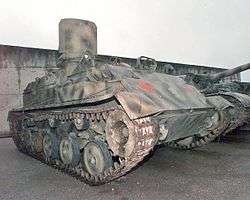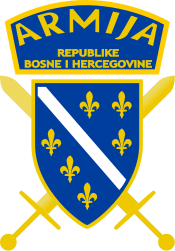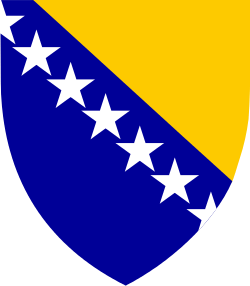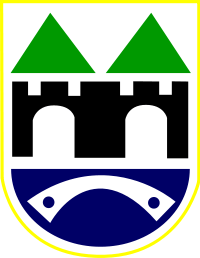Army of the Republic of Bosnia and Herzegovina
| Army of the Republic of Bosnia and Herzegovina Armija Republike Bosne i Hercegovine | |
|---|---|
|
Bosnian Army Emblem | |
| Founded | 15 April 1992 |
| Disbanded | 14 December 1995 |
| Service branches |
Bosnian Army Bosnian Air Force and Defense |
| Headquarters | Sarajevo, Republic of Bosnia and Herzegovina |
| Leadership | |
| Commander-in-Chief | President Alija Izetbegović |
| Defence Minister | Munib Bisić |
| Commander |
General Sefer Halilović (1992-1993) General Rasim Delić (1993-1995) |
| Manpower | |
| Active personnel | 90-120,000 ~200,000 (in 1995) |
| Related articles | |
| History | |
| Ranks | Military ranks and insignia of Bosnia and Herzegovina |
The Army of the Republic of Bosnia and Herzegovina (Bosnian: Armija Republike Bosne i Hercegovine, ARBiH) was the military force of the Republic of Bosnia and Herzegovina established by the government of Bosnia and Herzegovina in 1992 following the outbreak of the Bosnian War. Following the end of the war, and the signing of the Dayton Peace Agreement in 1995, it was transformed into the Army of the Federation of Bosnia and Herzegovina. The ArBiH was the only military force on the territory of Bosnia and Herzegovina recognised as legal by other governments. Under the State Defense Reform Law the Armed Forces of Bosnia and Herzegovina were unified into a single structure, OSBiH, making entity armies defunct.[1][2]
History
Creation and composition
The Army of Republic of Bosnia and Herzegovina was formed on 15 April 1992 during the early days of the Bosnian War.[3] Before the ARBiH was officially created, a number of paramilitary and civil defense groups were established. The Patriotic League (PL) and the local Territorial Defence Force of the Republic of Bosnia and Hercegovina (TORBIH) were the official army while paramilitaries such as the Zelene Beretke (Green Berets) and Crni Labudovi (Black Swans) units were also active. Other irregular groups included Bosnian mafia groups, as well as collections of police and former Yugoslav People's Army soldiers.
The army was formed in poor circumstances, and suffered from a very limited supply of arms. Critical deficiencies included tanks and other heavy weaponry. The first commander of the army was Sefer Halilović.
1992
In 1992, 70% of Bosnia was under JNA (Yugoslav People's Army), and then later VRS (Bosnian Serb Army), control. Sarajevo was under siege. The ARBiH had defended Sarajevo with light weaponry. The army was surrounded and the transfer of supplies was hard, if not impossible.
1993
1993 saw no major changes in the front lines against Serbs. Instead, this year marked the start of the Croat-Bosniak war in Central Bosnia and in Herzegovina, notably the Mostar region. Pressured and contained by heavily armed Serb forces in Bosnia-Hercegovina and Croatia, Croat forces - HVO (Croatian Defence Council) shifted their focus from defending their parts of Bosnia from Serbs to trying to capture remaining territory held by Bosnian Army. It is widely believed that this was due to the Karađorđevo agreement reached between presidents Slobodan Milošević and Franjo Tuđman to split Bosnia between Croatia and Serbia. In order to accomplish this Croatian forces would have to defeat the Bosnian Army, since the territory that they wanted was under Bosnian government control. HVO with great engagement from the Military of Republic of Croatia and material support from Serbs, attacked Bosniak civilian population in Herzegovina and in central Bosnia starting an ethnic cleansing of Bosniak populated territories (e.g. Lašva Valley ethnic cleansing). Vastly underequipped Bosnian forces, fighting on two fronts, were able to repel Croats and gain territory against them on every front. At this time, due to its geographic position, Bosnia was surrounded by Croat and Serb forces from all sides. There was no way to import weapons or food. What saved Bosnia at this time was its vast industrial complex (steel and other heavy industry), which was able to switch to military production. After a short but bloody war, and once Croats realized that their partnership with Serbs would not bring them any territorial gains, they agreed to US leadership's "Washington Treaty" peace agreement. From that point on, Croat and Bosnian government forces fought as allies against Serbs.
1994
A renewed alliance between HVO and ARBiH was agreed upon, with the objective of forming a strong force that could fight the much stronger and better equipped VRS. This was the time of frequent peace negotiations.
1995
Despite the loss of several enclaves, notably Srebrenica, 1995 was marked by HVO and ARBiH offensives and later by NATO intervention. Following the Split Agreement, the Croatian army, with cooperation from ARBiH and HVO, launched a series of operations: Flash, Summer '95, Storm and Mistral 2. In conjunction, Bosnian forces launched operations like Sana. Bosnian and Croat armies were on the offensive in this phase, captured all of western Bosnia, and the Serb capital Banja Luka was seriously threatened, until peace negotiations stopped further bloodshed.
In the period of August–December 1995, Serb forces were defeated and driven out of the majority of Croatia and western Bosnia, and the ethnic Serb population fled from these parts.
Following the second Markale massacre, NATO intervention was launched, which destroyed much of the VRS infrastructure in just a few days (Operation Deliberate Force). The war ended with the signing of the Dayton Accord.
Army Corps and Commanding Officers
The army was divided into Corps, each stationed in a particular territory. In 1993, most brigades were renamed as Mountain troops given that the lack of heavy weapons made it organizationally pointless to list them as infantry or motorized. In addition, Bosnian terrain favored light infantry over armored and mechanized formations.
Pre War
| Name | Headquarters | Information |
|---|---|---|
 |
Sarajevo | The Territorial Defence Force of the Republic of Bosnia and Hercegovina (Teritorijalna odbrana Bosne i Hercegovine (TO BiH) were the first official armed forces of Bosnia and Herzegovina at the beginning of the Bosnian War. Which eventually transformed into the Army of the Republic of Bosnia and Herzegovina. |
| The Patriotic League | Sarajevo | The Patriotic League was the first paramilitary unit of Territorial Defence Force of the Republic of Bosnia and Herzegovina.[4] Formed in March 1991. |
| Zelene beretke | Sarajevo | The "Green Berets" were a paramilitary organization founded in Sarajevo in early 1992. They were integrated into the newly founded Army of the Republic of Bosnia and Herzegovina in the second part of 1992. |
_patch.jpg) |
Sapna, Konjic | The Black Swans (Bosnian: Crni Labudovi) were a special forces unit in the Territorial Defence Force of the Republic of Bosnia and Hercegovina. |
Corps
| Name | Headquarters | Information |
|---|---|---|
| 1st Corps | Sarajevo | This corps was the first to be formed in 1992 and served in the protection of Sarajevo in the Siege. |
| 2nd Corps | Tuzla | This corps was formed in 1992 and had mayor success in holding Tuzla area and in operations like "Operation Vozuća". This was also the only corps which had direct connection at one time during the war with the Independent 81 Division. |
| 3rd Corps | Zenica | The corps was formed in 1992 and because of quick change in fighting, towns like Vareš were liberated. |
| 4th Corps | Mostar | The corps was famous for the successful defense of the city of Mostar. The corps was formed in 1992 and cooperated also with the Croatian Defence Forces. |
| 5th Corps | Bihać Sanski Most (1995) |
The 5th corps formed in 1992 was one of the most organised corps in the army. They liberated a lot of the territory of the Republic of Bosnia and Herzegovina in operations like: Operation Mistral 2, Operation Storm and Operation Sana. |
 |
Konjic | Formed 9 June 1993. Disbanded February 1994, some units incorporated in 7th Corps and the rest in 4th Corps. |
| 7th Corps | Jajce, Travnik | The corps was one of the most important as it liberated many territories. The highest success was the capturing of mountain Vlašić. |
| Eastern Bosnian Operational Group later, 28th Podrinje Independent Division | Srebrenica | This was not classified as a corps rather as an independent division because of not being connected to any corps. The job of this unit was to liberate territory around the Srebrenica enclave. |
| Eastern Bosnian Operational Group later, 81st Podrinje Independent Division | Goražde | This was not classified as a corps rather as an independent division because of not being connected to any corps. The job of this unit was to liberate territory around the Goražde enclave. |
Military Police and Special Forces
| Name | Headquarters | Information |
|---|---|---|
| Military Police of RBIH | Sarajevo | This was the official police force in the state from 1992 to 1995. |
| Special Police Squad "Bosna" | Sarajevo | Main special police forces unit, directly under the control of the presidency. |
| Black Swans (Incorporated into the ARBIH as an independent special force.) | Sarajevo | After the establishing of the ARBIH, the unit got the status of a "special purpose force". |
| High Command of Military Doctrines | Sarajevo | This was the team of researchers of Military doctrines during the war. |
Bosnian General Staff
- Alija Izetbegović (The Supreme Commander of the Bosnian Armed Forces)
- Hasan Efendić (First commander of the Territorial Defence Force of the Republic of Bosnia and Hercegovina)
- Sefer Halilović (Chief of Staff of the Main Staff and Commander of the Bosnian Army 1992-1993)
- Rasim Delić (Commander of Main Staff and Commander of the Bosnian Army 1993-1995)
- Jovan Divjak (deputy of the ARBIH commander 1992-1995)
- Stjepan Šiber (deputy of the ARBIH commander 1992-1995)
Corps commanders
- Mustafa Hajrulahović Talijan (first commander of the 1st Corps)
- Vahid Karavelić (second commander of the 1st Corps)
- Nedžad Ajnadžić (third commander of the 1st Corps)
- Željko Knez (first commander of the 2nd Corps)
- Hazim Šadić (second commander of the 2nd Corps)
- Sead Delić (third commander of the 2nd Corps)
- Enver Hadžihasanović (first commander of the 3rd Corps)
- Mehmed Alagić (second commander of the 3rd Corps, first commander of the 7th corps)
- Kadir Jusić (third commander of the 3rd Corps)
- Sakib Mahmuljin (fourth commander of the 3rd Corps)
- Arif Pašalić (first commander of the 4th Corps)
- Sulejman Budaković "Tetak" (second commander of the 4th Corps)
- Ramiz Dreković (first commander of the 5th Corps, third commander of the 4th corps)
- Atif Dudaković (second commander of the 5th Corps)
- Salko Gušić (first commander of the 6th Corps)
- Galib Hodžić (second commander of the 6th Corps)
- Zaim Imamović (commander of the Easter Bosnian Operational Group)
- Blaž Kraljević (commander of HOS and member of the Bosnian Army Chiefs of Staff)
- Mustafa Polutak (fourth commander of the 4th Corps)
Equipment
- List of equipment:[5]

Infantry weapons of Army of Bosnia and Herzegovina
Assault Rifles, Machine Guns
| Name | Origin | Type | Notes |
|---|---|---|---|
| MG42 | |
Machine gun | WW2 Model |
| Zastava M53 | |
Machine gun | provided from old JNA barracks, large numbers |
| M2 Browning machine gun | |
Machine gun | captured |
| DShK | |
Machine gun | captured and smuggled |
| NSV machine gun | |
Machine gun | captured, in smaller numbers |
| M48 Mauser | |
Bolt-action rifle | Some used as sniper rifles, fitted with ZRAK 4x32 telescopic sight |
| PAP M59/66 | |
Semi-automatic rifle | In large numbers, used as sniper rifles or by paramilitary |
| Zastava M72 | |
Assault rifle | In large Numbers |
| Zastava M76 | |
Sniper rifle | Captured/smuggled |
| Heckler & Koch MP5 | |
Submachine gun | |
| AK-47 and derivates | |
Assault rifle | In large numbers, mostly Romanian copies |
| Zastava M70 | |
Assault rifle | In large numbers |
| Škorpion vz. 61 | |
Submachine gun | Designed M84 Škorpion |
| Dragunov Sniper Rifle | |
Sniper Rifle | Smuggled |
| G3 | |
Assault rifle | In low numbers |
| Zastava M84 | |
Machine gun | In large numbers |
| Zastava M80 | |
Assault rifle | |
| Thompson submachine gun | |
submachine gun | In low numbers (All provided from old JNA barracks) |
Pistols
| Pistol | Origin | Type | Versions | Notes |
|---|---|---|---|---|
| TT pistol | |
Pistol | ||
| CZ-99 | |
Pistol | ||
Infantry anti-tank weapons
| Name | Origin | Type | Versions | Notes |
|---|---|---|---|---|
| M80 Rocket Launcher | |
Rocket Launcher | 64 mm | |
| M79 Osa | |
Rocket Launcher | 90 mm | |
| AT-3 Sagger | |
Anit-tank missile | ||
| HJ-8 | |
Anti-tank missile | Baktar-Shikan, HJ-8E | Was supplied to ARBiH in 1993-1995 |
| RPG-7 | |
Rocket-propelled grenade | ||
| M90 | |
Rocket Launcher | 120 mm | |
Artillery
| Artillery | Origin | Type | Versions | Notes |
|---|---|---|---|---|
| D-30 | |
Howitzer | D-30J | captured |
| BM-21 Grad | |
Multiple rocket launcher | BM-21 Grad/RM-70 | |
| M-63 | |
Multiple rocket launcher | M-63 Plamen | |
| M-77 | |
Multiple rocket launcher | M-77 Oganj | |
| M-87 | |
Multiple rocket launcher | few | |
| Type 63 multiple rocket launcher | |
Multiple rocket launcher | Large Number | |
Main battle tanks
| Tanks | Origin | Type | Notes |
|---|---|---|---|
| T-34 | |
Main battle tank | 46 tanks |
| M-84 | |
Main battle tank | captured, 3 vehicles |
| T-55 | |
Main battle tank | 60 tanks |
| PT-76 | |
light tank | |
| M47 Patton | |
Main battle tank | 13 |
Armored Personnel Carriers
| APC | Origin | Notes |
|---|---|---|
| BVP M-80 | |
|
| OT M-60 | |
|
| BOV (APC) | |
from police and captured from VRS |
| BRDM-2 | |
~3 vehicles |
Self-Propelled Anti-Aircraft Artillery
| System | Origin | Notes |
|---|---|---|
| ZSU-57-2 | |
<10 Vehicles |
| M53/59 Praga | |
<5 vehicles |
Anti-Aircraft Artillery
| System | Origin | Notes |
|---|---|---|
| Bofors 40 mm | |
|
| ZU-23-2 | |
mainly used against ground targets |
Self-Propelled Artillery
| System | Origin | Notes |
|---|---|---|
| 2S1 Gvozdika | |
(captured 1994-95) |
| M36 Tank Destroyer | |
|
| M18 Hellcat | |
|
See also
References
External links
- Ministry of Defense
- Army of the Republic of Bosnia and Herzegovina (English)
- Vojska.net
- Armijabih.com


